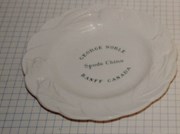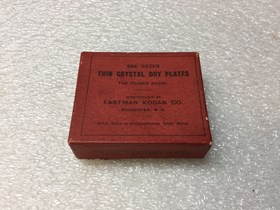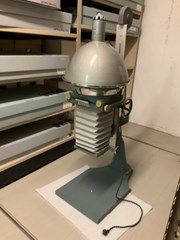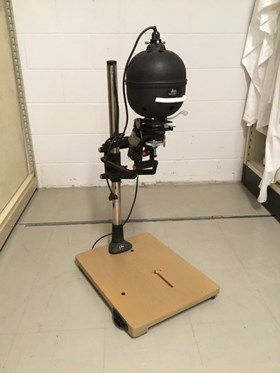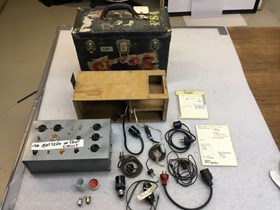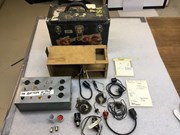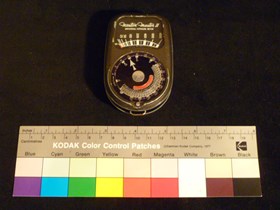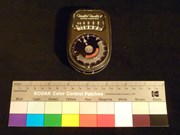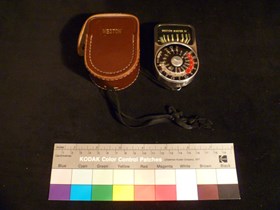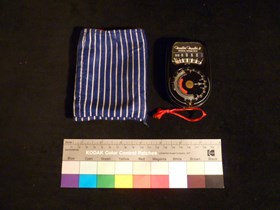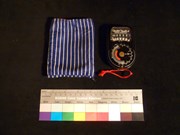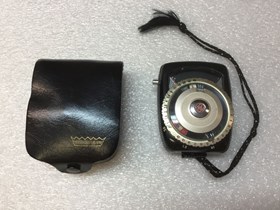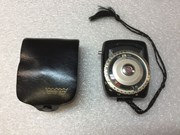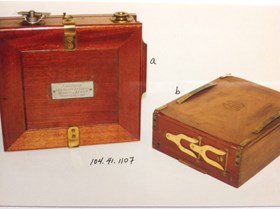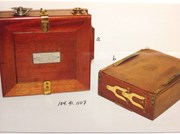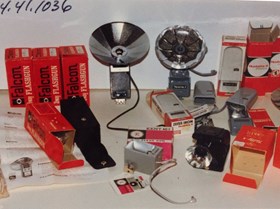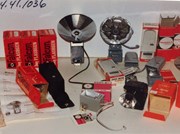Narrow Results By
- Date
- 1920 – 1940
- Material
- ceramic
- Catalogue Number
- 104.20.1104
- Description
- Small white china plate with a scalloped edge and three tulips and leaves in relief on the rim. The plate has green printing on the face: “George Noble Spode China Banff, Canada” and the Copeland Spode trademark on the bottom.
1 image
- Title
- Dish
- Date
- 1920 – 1940
- Material
- ceramic
- Description
- Small white china plate with a scalloped edge and three tulips and leaves in relief on the rim. The plate has green printing on the face: “George Noble Spode China Banff, Canada” and the Copeland Spode trademark on the bottom.
- Credit
- Purchased from Phyllis Cain, Banff, 1988
- Catalogue Number
- 104.20.1104
Images
This material is presented as originally created; it may contain outdated cultural descriptions and
potentially offensive content.
Read more.
- Date
- 1920 – 1940
- Material
- cardboard; paper; glass;
- Catalogue Number
- 104.41.0220
- Description
- Box of one dozen Thin Crystal Dry Plates for a Pocket Kodak camera. The box’s seal has been broken - inside are alternating layers of thin black paper and the glass plates, which are fogged.Dry plate, or the gelatin process, was invented by Dr. Richard L. Maddox in 1871 and replaced the more time-c…
1 image
- Title
- Dry Plates
- Date
- 1920 – 1940
- Material
- cardboard; paper; glass;
- Dimensions
- 1.9 x 6.0 x 5.1 cm
- Description
- Box of one dozen Thin Crystal Dry Plates for a Pocket Kodak camera. The box’s seal has been broken - inside are alternating layers of thin black paper and the glass plates, which are fogged.Dry plate, or the gelatin process, was invented by Dr. Richard L. Maddox in 1871 and replaced the more time-consuming wet plate, or collodion process, which required active wet chemicals to be prepared in mobile dark rooms. The dry plate process underwent several adaptations throughout the 1870s and, in 1879, George Eastman developed a method of applying the emulsion layer to glass in a factory setting, simultaneously creating what came to be known as the Eastman Kodak Co. and bringing down the cost of photography so as to be accessible to the masses.
- Subject
- photography
- photographic equipment
- Credit
- Gift of Catharine Robb Whyte, O. C., Banff, 1979
- Catalogue Number
- 104.41.0220
Images
This material is presented as originally created; it may contain outdated cultural descriptions and
potentially offensive content.
Read more.
Dry Plates Box
https://archives.whyte.org/en/permalink/artifact104.41.0263
- Date
- prior to 1977
- Material
- paper
- Catalogue Number
- 104.41.0263
- Description
- A blue, empty Cramer’s Photo Dry Plates box. The label of the box is a lighter blue, with a dark blue border around the edges. The black text reads “CRAMER’S” “Photo Dry Plates.” “DIRECTIONS INSIDE.” “MANUFACTURED BY” “G. Cramer Dry Plate Co.,” “St. Louis, Mo., U.S.A.” “NEW YORK DEPOT: 93 Universit…
1 image
- Title
- Dry Plates Box
- Date
- prior to 1977
- Material
- paper
- Dimensions
- 2.8 x 11.0 x 13.8 cm
- Description
- A blue, empty Cramer’s Photo Dry Plates box. The label of the box is a lighter blue, with a dark blue border around the edges. The black text reads “CRAMER’S” “Photo Dry Plates.” “DIRECTIONS INSIDE.” “MANUFACTURED BY” “G. Cramer Dry Plate Co.,” “St. Louis, Mo., U.S.A.” “NEW YORK DEPOT: 93 University Place.” “Keep in a Dry, Dimly Lighted Place.” “Open in Dark Room Only.” At the top of the lid is handwriting in pencil, “Box No. 3 finished”. Along one edge is another blue label, an anchor illustration “ANCHOR Brand.” “CRAMER PLATES.” “Emulsion 18544” “ONE DOZ. 4 x 5”. There is a brown tape along the edge of the lid. The bottom of the box is stamped with “185445 A10” “THIS” “TRADE-MARK” “REGISTERED IN Anchor” “U.S. PAT. OFFICE.” The inside of the box is a golden yellow. Along the edges of the bottom of the box, is a gingham printed tape.
- Credit
- Gift of Pearl Evelyn Moore, Banff, 1977
- Catalogue Number
- 104.41.0263
Images
This material is presented as originally created; it may contain outdated cultural descriptions and
potentially offensive content.
Read more.
Dry Plates Box
https://archives.whyte.org/en/permalink/artifact104.41.0271
- Date
- prior to 1977
- Material
- cardboard;
- Catalogue Number
- 104.41.0271
- Description
- An empty Eastman’s Dry Plate box with a label on the lid. Along the edge of the lid is a red border, in a beige square with a smaller black square text reads “Eastman’s” “Dry Plates” “MANUFACTURED BY” “EASTMAN KODAK CO.,” “ROCHESTER, N.Y.” “TO BE OPENED ONLY IN PHOTOGRAPHIC DARK ROOM.” There is pen…
1 image
- Title
- Dry Plates Box
- Date
- prior to 1977
- Material
- cardboard;
- Dimensions
- 2.9 x 13.8 x 11.3 cm
- Description
- An empty Eastman’s Dry Plate box with a label on the lid. Along the edge of the lid is a red border, in a beige square with a smaller black square text reads “Eastman’s” “Dry Plates” “MANUFACTURED BY” “EASTMAN KODAK CO.,” “ROCHESTER, N.Y.” “TO BE OPENED ONLY IN PHOTOGRAPHIC DARK ROOM.” There is pencil handwriting along the top of the label which reads “Lila Aunt Lizzie”. Along one of the edges of the lid a sticker/label that is partially torn making it illegible. Inside the lid is another box with a white sticker label that reads “Emulsion No. 5599” “Packer No. 13” “If these plates are found to be defective, the user will confer a favor by returning them direct to the manufacturer in this box, together with a negative, and his name, address, and a statement of the trouble written hereon” “EASTMAN KODAK CO.,” “Rochester, N.Y., U.S.A.” “KODAK, LIMITED” “43 Clerkenwell Road, London.” “Paris. Berlin. Brussels. Vienna. St. Petersburg. Moscow. Liverpool. Glasgow. Melbourne.” There is some pencil markings as well. The edges are held with tape. The inside of this box is golden yellow.
- Credit
- Gift of Pearl Evelyn Moore, Banff, 1977
- Catalogue Number
- 104.41.0271
Images
This material is presented as originally created; it may contain outdated cultural descriptions and
potentially offensive content.
Read more.
- Date
- 1950 – 1965
- Material
- metal; plastic; fabric;
- Catalogue Number
- 104.41.0162
- Description
- Large photographic negative enlarger. Mostly made of blue-grey metal, the enlarger consists of a large rectangular base with a support arm rising from the back which holds the enlarging mechanism. Hand-crank wheels on either side of the support arm allows the enlarger to be moved up and down. The t…
1 image
- Title
- Englarger
- Date
- 1950 – 1965
- Material
- metal; plastic; fabric;
- Dimensions
- 140.0 x 40.0 x 74.0 cm
- Description
- Large photographic negative enlarger. Mostly made of blue-grey metal, the enlarger consists of a large rectangular base with a support arm rising from the back which holds the enlarging mechanism. Hand-crank wheels on either side of the support arm allows the enlarger to be moved up and down. The top of the enlarger is a large silver dome [possibly the light] with the black and white fabric-wrapped power cord coming out the top, the dome sits on top of the main blue-grey metal tray where more dials can adjust settings and the tray for inserting the original negative sides out the front, coming out the bottom of the frame is a grey bellows that has the focussing lens on the bottom.
- Subject
- Nicholas Morant
- photography
- photograph equipment
- darkroom
- camera equipment
- photograph developing
- Credit
- Gift of Nicholas Morant, Banff, 2006
- Catalogue Number
- 104.41.0162
Images
This material is presented as originally created; it may contain outdated cultural descriptions and
potentially offensive content.
Read more.
- Date
- 1920 – 1945
- Material
- wood; metal; glass; plastic;
- Catalogue Number
- 104.41.0170
- Description
- Black and silver metal Leitz negative enlarger mounted on a wooden base. The enlarger consists of an almost round light housing with the power cord coming out from the top - immediately below the globe is a series of plates containing the various filters and lenses, as well as the mounting gear tha…
1 image
- Title
- Enlarger
- Date
- 1920 – 1945
- Material
- wood; metal; glass; plastic;
- Dimensions
- 95.8 x 41.7 x 51.9 cm
- Description
- Black and silver metal Leitz negative enlarger mounted on a wooden base. The enlarger consists of an almost round light housing with the power cord coming out from the top - immediately below the globe is a series of plates containing the various filters and lenses, as well as the mounting gear that attaches the enlarger to the silver metal stand. The enlarger is attached to the stand with adjustable arms and a spring that can be released with a small lever so that the device can be moved closer to or further away from the wooden base.
- Credit
- Gift of Nicholas Morant, Banff, 2006
- Catalogue Number
- 104.41.0170
Images
This material is presented as originally created; it may contain outdated cultural descriptions and
potentially offensive content.
Read more.
Enlarger Holder
https://archives.whyte.org/en/permalink/artifact104.41.0127
- Date
- 1950 – 1980
- Material
- cardboard;
- Catalogue Number
- 104.41.0127
- Description
- A box containing a 4x5 enlarger holder, as identified in black ink written on one short end of the cardboard box. The box’s original paper adhesive holding it closed has been cut, but a piece of yellow tape has been placed horizontally over the opening, keeping it closed.
1 image
- Title
- Enlarger Holder
- Date
- 1950 – 1980
- Material
- cardboard;
- Dimensions
- 1.6 x 5.5 x 21.5 cm
- Description
- A box containing a 4x5 enlarger holder, as identified in black ink written on one short end of the cardboard box. The box’s original paper adhesive holding it closed has been cut, but a piece of yellow tape has been placed horizontally over the opening, keeping it closed.
- Credit
- Gift of Nicholas Morant, Banff, 2006
- Catalogue Number
- 104.41.0127
Images
This material is presented as originally created; it may contain outdated cultural descriptions and
potentially offensive content.
Read more.
- Date
- 1950 – 1980
- Material
- leather; metal; wood; glass; paper; plastic
- Catalogue Number
- 104.41.0102 a-h
- Description
- Hard-sided black travel case with metal corner brackets, reinforcements along all edges, metal loops on both short sides with a remnant of a leather strap attached to the right-hand loop, a leather handle attached to the lid with metal brackets, wooden runners on the bottom and front of the case, a…
1 image
- Title
- Equipment Case
- Date
- 1950 – 1980
- Material
- leather; metal; wood; glass; paper; plastic
- Dimensions
- 93.4 x 25.5 x 41.8 cm
- Description
- Hard-sided black travel case with metal corner brackets, reinforcements along all edges, metal loops on both short sides with a remnant of a leather strap attached to the right-hand loop, a leather handle attached to the lid with metal brackets, wooden runners on the bottom and front of the case, and three metal clasps - the centre one of which has a keyhole. Attached to the handle on the lid is a leather travel tag with a clear plastic window through which Morant’s Canadian Pacific details are visible.The interior of the case lined with beige fabric and is divided into five compartments in the main body (in addition there are two inserts, one a box the other a panel, that sit on supports) and three compartments in the lid. Two of the lid compartments have aluminum foil lining the backs.Contents of the case include:b : thirteen film magazines, some of which are wrapped in paper. c : two Spiralite and two Kodak lenses - the Spiralite ones are housed in leather pouches and one of the Kodak ones is housed in the original yellow “Kodak Pola-Screen” cardboard box.d : three Technika lenses housed in fabric bags - one is a deep blue velvet bag with a gold drawstring, one is a blue-green bag with red cord trim that snaps closed, and one is a patterned red structured fabric box with metal clasps.e : miscellaneous tools and includes fold-out magnifying glasses in leather envelopes, remote triggers, wooden spacers, pliers, micro screwdrivers, a timer attachment in a small leather case, a pen flashlight, and a small flat-headed screwdriver.f : assorted papers and manuals - also includes “Photographic Authorization” forms for use of Morant’s photographs.h : four lens hoods. Two are housed in fabric bags, one a purple Crown Royal bag and one in a red and blue bag. g : various filters - most are Kodak and housed in their original paper/cardboard boxes/sleeves and most have their identifier written on the box possibly by Morant.
- Credit
- Gift of Nicholas Morant, Banff, 2006
- Catalogue Number
- 104.41.0102 a-h
Images
This material is presented as originally created; it may contain outdated cultural descriptions and
potentially offensive content.
Read more.
Equipment Case
https://archives.whyte.org/en/permalink/artifact104.41.0103
- Date
- 1950 – 1980
- Material
- leather; wood; metal; fabric
- Catalogue Number
- 104.41.0103
- Description
- Brown hard-sided travel case with metal corner brackets, reinforcing along all edges, wooden runners along the bottom, front, and back of the case, a leather handle on the lid attached with leather brackets and metal loops, and three metal clasps - the centre one has a keyhole. Attached to the righ…
1 image
- Title
- Equipment Case
- Date
- 1950 – 1980
- Material
- leather; wood; metal; fabric
- Dimensions
- 29.8 x 14.9 x 78.3 cm
- Description
- Brown hard-sided travel case with metal corner brackets, reinforcing along all edges, wooden runners along the bottom, front, and back of the case, a leather handle on the lid attached with leather brackets and metal loops, and three metal clasps - the centre one has a keyhole. Attached to the right-hand metal loop of the handle is a leather travel tag with nothing in it. Throughout the exterior of the case are three faded and worn red and white “FRAGILE CANADIAN PACIFIC EXPRESS” stickers - one on the lid and one on both the front and back - and a Canadian Pacific Railway “DEPARTMENT OF PUBLIC RELATIONS” label with a very faded stamp with Morant’s details. Also on the lid is a gold and red sticker is in the left corner with the case’s manufacturer name - no information about “G.R. TAYLOR & CO.” could be found online.The interior of the case is lined with purple fabric and only contains a small white fabric bag with what feels like rice inside, sealed shut.
- Credit
- Gift of Nicholas Morant, Banff, 2006
- Catalogue Number
- 104.41.0103
Images
This material is presented as originally created; it may contain outdated cultural descriptions and
potentially offensive content.
Read more.
- Date
- 1950 – 1970
- Material
- metal; wood; plastic; leather; paper;
- Catalogue Number
- 104.41.0153 a-e
- Description
- Black hard-sided travel case with metal brackets on the corners, a hinged lid with three metal clasps, and a leather handle attached to the top of the lid with metal loops. The exterior of the case has the remnants of stickers and labels throughout, including a large red and white sticker on the fr…
1 image
- Title
- Equipment Case
- Date
- 1950 – 1970
- Material
- metal; wood; plastic; leather; paper;
- Dimensions
- 30.7 x 20.3 x 40.7 cm
- Description
- Black hard-sided travel case with metal brackets on the corners, a hinged lid with three metal clasps, and a leather handle attached to the top of the lid with metal loops. The exterior of the case has the remnants of stickers and labels throughout, including a large red and white sticker on the front that reads “GLASS.” Attached to the handle by a piece of string is the torn remnants of a CP Rail paper tag. The interior of the box is lined with dark blue velvet and contains a wood particle board box that, when lifted out, exposes three built-in compartments - the small upper one on the right has an opening cut into the top so that the contents could be accessed without removing it from the case. The two smaller compartments of the box contain a miscellaneous collection of power cords and a white metal film canister containing two small light bulbs. Two cords are fed through small holes drilled between the compartments.Sitting on top of the particle board box is a sealed metal light switchboard with various switches, plug outlets, and coloured lights across the top - two more outlets are located on one short side. Resting on top is a strip of paper that reads “NO BATTERY IN TRIP CIRCUIT” in black ink. This switchboard would allow Morant to synchronize and set off studio lights and/or camera flashes from one central location. Also included in the box are two pieces of paper - one is an equipment checklist written on the back of a note card, and the other is a hand-written circuit manual in a plastic envelope.
- Credit
- Gift of Nicholas Morant, Banff, 2006
- Catalogue Number
- 104.41.0153 a-e
Images
This material is presented as originally created; it may contain outdated cultural descriptions and
potentially offensive content.
Read more.
Exposure Meter
https://archives.whyte.org/en/permalink/artifact104.41.1118
- Date
- 1888
- Material
- metal; paint; plastic
- Catalogue Number
- 104.41.1118
- Description
- Hand held exposure/light meter made by Weston Electrical Instrument Company in a grey metal finish. Along both sides of the meter are a series of protruding lines that allow one to safely grip the object. At the bottom of the artifact there is a metal hook, which would have allowed a string to be a…
1 image
- Title
- Exposure Meter
- Date
- 1888
- Material
- metal; paint; plastic
- Dimensions
- 2.0 x 6.0 x 9.5 cm
- Description
- Hand held exposure/light meter made by Weston Electrical Instrument Company in a grey metal finish. Along both sides of the meter are a series of protruding lines that allow one to safely grip the object. At the bottom of the artifact there is a metal hook, which would have allowed a string to be attached like on the other Weston meter’s owned by Nicholas. There is also no longer a case to protect this particular object. In the top of the exposure meter there is a clear plastic covering. Along the very top there us the name of the manufacturer in white cursive lettering that reads “Weston Master II” and written underneath in capital letters “UNIVERSAL EXPOSURE METER.” Below this is the light scale where the value of the scene would be indicated. The scale contains the values “0” “25” “50” “100” “200” “400” “800” “1600,” which means that the two values on this instrument are calibrated 0-50 and 0-1600. (candles per square foot.)Below there is a circular face with several figures and a dial that turns/rotates. The outside row of figures on the exposure control dial represents the light value settings and corresponds to the light values on the light scale. Below the round dial there is a tiny circular button that is used to set the exposure control dial for film speed. As the dial turns it reveals the “EMULSION SPEED” with a red baize finish that has become worn throughout its life. The row of figures at the bottom of the top dial is the f/stop values and has an “f” to make this more apparent for the user. The row of figures directly below the f/stop settings are the shutter speeds. After setting the exposure control dial to the light value obtained on the light scale, any of the combinations of f/stop and shutter speed directly opposite each other are correct. On the rear of the meter there is a black plastic covering that contains several circular cut outs that are called a hir.ged baffle. This can be swung open (against the case) using the gold latch, which clips into a tiny hole or socket when the user wishes it to be closed. When opened the light sensitive photo cell is directly beneath this baffle and contains several protruding circles. When the baffle is open, the scale range is 0-50; when the baffle is closed, the scale range is 0-1600. Below there is an oval shaped face with extensive information that is held in place with two small screws on both the viewer left and right side. There is silver lettering on a black background that reads “WESTON ELEC. INST. CORP.” “NEWARK, N.J., U.S.A.” A silver backing separates the patent information and has black writing that reads “MODEL 735” on the viewer left side. On the viewer right side the number “7454510” is engraved. In the middle there is a gold-coloured screw with the words “ZERO CORRECTOR” written in black. Below this there is the patent information; “U.S. PATENTS” “2,274,441” “2,073,790” “2,346,555” “2,137,466” “2,463,770.” Below these numbers are the “FOREIGN PATENTS” “FRENCH 862,770” “BRITISH 531,996” “CAN. 347,085” “CAN. 411,975” At the very bottom underneath there is the manufacturer’s location; “MADE IN U.S.A.”
- Subject
- photography
- Nick Morant
- Credit
- Gift of Nicholas Morant, Banff, 2006
- Catalogue Number
- 104.41.1118
Images
This material is presented as originally created; it may contain outdated cultural descriptions and
potentially offensive content.
Read more.
- Date
- 1888
- Material
- leather; metal; nylon; plastic; thread; paint
- Catalogue Number
- 104.41.1119 a-b
- Description
- Hand held light meter in a pear shape with a stainless steel body and leather case. Along both sides of the meter are a series of protruding lines that allow one to safely grip the object. On the viewer right there is a pointer lock, which is locked when positioned upwards and released when positio…
1 image
- Title
- Exposure Meter
- Date
- 1888
- Material
- leather; metal; nylon; plastic; thread; paint
- Dimensions
- 2.0 x 5.0 x 9.0 cm
- Description
- Hand held light meter in a pear shape with a stainless steel body and leather case. Along both sides of the meter are a series of protruding lines that allow one to safely grip the object. On the viewer right there is a pointer lock, which is locked when positioned upwards and released when positioned downward. At the bottom of the artifact there is a metal hook, which has a black string running through. In the top of the light meter there is clear plastic covering. Written in capital letters is “WESTON MATER IV” above the light scale. The lights scale contains the numbers “0” “25” “50” “100” “200” “400” “800” “1600,” which means that the 2 values calibrated on this instrument are 0-50 and 0-1600.Below there is another light scale in the form of a circular face with several figures and a dial that turns/rotates. The dial on the outside has a series of protruding lines to make movement easier and contains a row of figures. This dial controls the lens aperture (f/stop) scale and has a series of values representing the focal length of the lens; “1” “1.4” “2” “2.8” “4” “5.6”. On the same dial there is also the letters “EVS,” which stands for the exposure value setting with a cut out window that reveals the EVS values. Working in a clockwise direction (on the same dial) there is also the letters “U,” “A with “1/2” over top,” an enclosed arrow that is known as the normal arrow, a “C” with “2x” on top of it, and a “0”. As this dial is turned it reveals a partly red baize and black numbers on a silver background that represents the shutter speeds in fractions of seconds. The inside dial has a series of light scale values and an exposure index window that line up with the “U,” “A,” normal arrow, “C,” and “0.” On the opposite side of the exposure index window is the exposure index knob. On the rear of the meter there is a black plastic covering that contains several circular cut outs that are called a hir.ged baffle. This can be swung open (against the case) using the gold latch, which clips into a tiny hole or socket when the user wishes it to be closed. When opened the light sensitive photo cell is directly beneath this baffle and contains several protruding circles. When the baffle is open, the scale range is 0-50; when the baffle is closed, the scale range is 0-1600. Below there is an oval shaped face with extensive information that is held in place with two small screws on both the viewer left and right side. There is black lettering on a silver background that reads “UNIVERSAL EXPOSURE METER” “MODEL 745” SER.W” and “107522” engraved. Below the manufacturer information is listed; “DAYSTROM. INCORPORATED” “WESTON INSTRUMENTS DIVISION”. “NEWARK. N.J.. U.S.A.” In the middle there is a gold-coloured screw with the words “ZERO CORRECTOR” written in black. On the viewer left side of the zero corrector there is patent information; “U.S. PATENTS” “2463770” and on the viewer right side “FOREIGN PATS” “CAN. 411975”. At the very bottom on either side of a circular cut out are “ASA” and “K=1.0” written. Underneath “MADE IN JAPAN” has also been written.There is also a brown leather case with this object. The front has “WESTON” written in gold letters. On the viewer left there is a brown button that allows the case to be opened or fastened shut. The leather has been stitched together with light brown thread that is visible. The bottom of the case has an opening for the black string to be strung through so that the light meter and case are attached. On the rear there is a brown leather strap stitched.
- Subject
- photography
- Nick Morant
- Credit
- Gift of Nicholas Morant, Banff, 2006
- Catalogue Number
- 104.41.1119 a-b
Images
This material is presented as originally created; it may contain outdated cultural descriptions and
potentially offensive content.
Read more.
- Date
- 1888
- Catalogue Number
- 104.41.1120 a-b
- Description
- Hand held light meter in a pear shape with a stainless steel body and leather case. Along both sides of the meter are a series of protruding lines that allow one to safely grip the object. At the bottom of the artifact there is a metal hook, which has a red string running through.There is a clear p…
1 image
- Title
- Exposure Meter
- Date
- 1888
- Description
- Hand held light meter in a pear shape with a stainless steel body and leather case. Along both sides of the meter are a series of protruding lines that allow one to safely grip the object. At the bottom of the artifact there is a metal hook, which has a red string running through.There is a clear plastic covering located at the top of the meter. Written in cursive letters is the company name “WESTON MATER II”. Underneath this written in capital letters is “UNIVERSAL EXPSOURE METER”. The light scale underneath contains the numbers “0” “25” “50” “100” “200” “400” “800” “1600,” which means that the 2 values calibrated on this instrument are 0-50 and 0-1600. Underneath the scale the word “Light” is present. Below there is another light scale in the form of a circular face with several figures and a dial that turns/rotates. The outside row of figures on the exposure control dial represents the light value settings and corresponds to the light values on the light scale at the top. The row of figures at the bottom of the top dial is the f/stop values and has an “f” to make this more apparent for the user.. On the same dial there is silver letters that have a line that correspond to the figures on the outside dial; “U,” “A with “1/2” underneath,” an arrow that is known as the normal arrow, a “C” with “2x” below it, and a “0”. As this dial is turned it reveals a partly red baize and the emulsion speed, which is self-evident as the words “EMULSION SPEED” are present. The row of figures directly below the f/stop settings are the shutter speeds. The outside row of figures is the light values, which is apparent as the word “LIGHT” with an arrow points to these values. After setting the exposure control dial to the light value obtained on the light scale, any of the combinations of f/stop and shutter speed directly opposite each other are correct. Below the round dial there is a tiny circular button that is used to set the exposure control dial for film speed.On the rear of the meter there is a black plastic covering that contains several circular cut outs that are called a hir.ged baffle. This can be swung open (against the case) using the gold latch, which clips into a tiny hole or socket when the user wishes it to be closed. When opened the light sensitive photo cell is directly beneath this baffle and contains several protruding circles. When the baffle is open, the scale range is 0-50; when the baffle is closed, the scale range is 0-1600. Below there is an oval shaped face with extensive information that is held in place with two small screws on both the viewer left and right side. There is silver lettering on a black background that reads “WESTON ELEC. INST. CORP.” “NEWARK, N.J., U.S.A.” A silver backing separates the patent information and has black writing that reads “MODEL 735” on the viewer left side; “No” is present in the middle; “8284703” is engraved on the viewer right side. In the middle there is a brass screw with the words “ZERO CORRECTOR” written in black around its circumference. On the viewer left side of the zero corrector is the patent information; “U.S. PATENTS” “1,779,574” “1,982,406” “2,073,790” and on the viewer right side continued patent information “U.S. PATENTS” “2,137,466” “2,274,441” “2,346,555”. Below these numbers are the “FOREIGN PATENTS” “FRENCH 862,770” “BRITISH 531,996” “CAN. 347,085” “CAN. 411,975” At the very bottom underneath there is the manufacturer’s location; “MADE IN U.S.A.” written in black on a silver background.There is also a blue case with white stripes and a red inner lining that would be used to protect the case. This would not have been originally sold with the exposure meter and was most likely hand made in an effort to protect the meter. Blue stitches hold the fabric together and are visible.
- Subject
- photography
- Nick Morant
- Credit
- Gift of Nicholas Morant, Banff, 2006
- Catalogue Number
- 104.41.1120 a-b
Images
This material is presented as originally created; it may contain outdated cultural descriptions and
potentially offensive content.
Read more.
Exposure Meter
https://archives.whyte.org/en/permalink/artifact104.41.0141
- Date
- 1955 – 1958
- Material
- metal; plastic; leather; fabric
- Catalogue Number
- 104.41.0141
- Description
- A General Electric Exposure Meter (type PR-3) in a black leather pouch. The meter has several dials on the front in order to set the exposure, a silver metal button on the left-hand side, a brief instruction plate attached to the back, and a black and gold fabric cord attached to the bottom. It is …
1 image
- Title
- Exposure Meter
- Date
- 1955 – 1958
- Material
- metal; plastic; leather; fabric
- Dimensions
- 3.4 x 6.7 x 8.2 cm
- Description
- A General Electric Exposure Meter (type PR-3) in a black leather pouch. The meter has several dials on the front in order to set the exposure, a silver metal button on the left-hand side, a brief instruction plate attached to the back, and a black and gold fabric cord attached to the bottom. It is mostly made of black plastic - the dials on the front and instruction plate on the back are both metal. The leather pouch has a front flap that snaps closed at the bottom and is mostly open on the inside so as to access the meter’s dials - there are openings on the left-hand side and the bottom for the button and cord. In the bottom right corner of the front flap is an embossed gold crown.
- Credit
- Gift of Nicholas Morant, Banff, 2006
- Catalogue Number
- 104.41.0141
Images
This material is presented as originally created; it may contain outdated cultural descriptions and
potentially offensive content.
Read more.
- Date
- prior to 1970
- Material
- metal; paper
- Catalogue Number
- 110.01.1050
- Description
- Metal film canisters, 54 in number, in colours of yellow, red, green, white and blue. In a paper box with paper dividers. Box is "Buchan-Sinclair Limited"
- Title
- Film Canister
- Date
- prior to 1970
- Material
- metal; paper
- Description
- Metal film canisters, 54 in number, in colours of yellow, red, green, white and blue. In a paper box with paper dividers. Box is "Buchan-Sinclair Limited"
- Subject
- hobbies
- photography
- Credit
- Gift of Catharine Robb Whyte, O. C., Banff, 1979
- Catalogue Number
- 110.01.1050
This material is presented as originally created; it may contain outdated cultural descriptions and
potentially offensive content.
Read more.
Film Magazine Case
https://archives.whyte.org/en/permalink/artifact104.41.0085
- Date
- 1920 – 1940
- Material
- leather; fabric; metal; paper
- Catalogue Number
- 104.41.0085
- Description
- Black hard-sided leather case with a hinged lid that clasps shut with two metal clasps on either side of a metal hinge lock and metal corner braces. There are two metal bases attached to the lid where a handle may have been attached, handle missing. Faded leather strap is attached with metal clasps…
1 image
- Title
- Film Magazine Case
- Date
- 1920 – 1940
- Material
- leather; fabric; metal; paper
- Dimensions
- 27.7 x 34.1 cm
- Description
- Black hard-sided leather case with a hinged lid that clasps shut with two metal clasps on either side of a metal hinge lock and metal corner braces. There are two metal bases attached to the lid where a handle may have been attached, handle missing. Faded leather strap is attached with metal clasps to rings mounted on both short sides of the case. There is a small square sticker, possibly a travel marker from Mexico, on the left-hand short side under the clasp. In the middle of the lid is a rectangular Canadian Pacific label that has “Film Case” written in black ink and a stamped “PROPERTY OF NICHOLAS MORANT BANFF, ALBERTA” in blue ink. Attached with a short piece of white string to the right-hand carry strap clasp is a paper Canadian Pacific tag that has something written in black ink that is badly damaged by water. A cataloguer tag is also attached to that clasp with “MORANT COLLECTION (film magazines)” written on it in black ink.The interior of the box is lined with a dark red fabric, possibly velvet and is divided into two compartments, the left one slightly larger than the right. The interior of the lid is also divided into two compartments that close off with snaps - small leather pull tabs allowed the compartments to be accessed. There are no manufacturer’s marks on the case. Found inside are three different film magazines.
- Credit
- Gift of Nicholas Morant, Banff, 2006
- Catalogue Number
- 104.41.0085
Images
This material is presented as originally created; it may contain outdated cultural descriptions and
potentially offensive content.
Read more.
- Date
- 1920 – 1940
- Material
- metal; leather; plastic; celluloid
- Catalogue Number
- 104.41.0086 a-c
- Description
- Three black metal and leather “GRAFLEX CUT FILM MAGAZINE,” used to store individual celluloid negatives mounted into individual sleeves housed inside the main body. Access to the main body is possible by removing the the thin back panel with a leather strap that slides up alongside the leather bag …
1 image
- Title
- Film Magazines
- Date
- 1920 – 1940
- Material
- metal; leather; plastic; celluloid
- Dimensions
- 11.0 x 3.5 x 6.5 cm
- Description
- Three black metal and leather “GRAFLEX CUT FILM MAGAZINE,” used to store individual celluloid negatives mounted into individual sleeves housed inside the main body. Access to the main body is possible by removing the the thin back panel with a leather strap that slides up alongside the leather bag as well by pressing a button on the edge opposite the leather bag, allowing the front panel to pop open. On the front panel that can pop off is a small peephole accessible by a spring-hinged cover. Two of the magazines, marked with a red and a white strip of fabric, have the front panels taped closed with a small piece of masking tape.The three magazines are meant for different kinds of film. The one marked with a small strip of green fabric is meant for “KODAK EXTACOLOR Professional Type S (Short Exposure),” the one marked with the red fabric is meant for “KODAK EKTACHROME Film 6116, Type B (Process E-3),” and the one marked with the white fabric is meant for “KODAK TRI-X PAN SHEET FILM (ESTAR Thick Base).” The individual slides housed inside the magazine with the green fabric may have unprocessed fogged negatives still in them.
- Subject
- Nicholas Morant
- photography
- Kodak
- film photography
- photo developing
- Canadian Pacific Railway
- Credit
- Gift of Nicholas Morant, Banff, 2006
- Catalogue Number
- 104.41.0086 a-c
Images
This material is presented as originally created; it may contain outdated cultural descriptions and
potentially offensive content.
Read more.
- Date
- 1885 – 1900
- Material
- wood; metal
- Catalogue Number
- 104.41.1107 a,b
- Description
- (a) Wooden film roller with brass fittings. Metal plate on top reads: “EASTMAN DRY PLATE & FILM CO. Rochester, N.Y., U.S.A. PATENTED MAY 5, 1885.” (b) Wooden film roller with brass fittings, top stamped: “EASTMAN KODAK CO. PAT. MAY 5, 1885. OTHER PATENTS APPL’D FOR IN ALL COUNTRIES.”
1 image
- Title
- Film Roller
- Date
- 1885 – 1900
- Material
- wood; metal
- Dimensions
- 6.0 x 18.0 cm
- Description
- (a) Wooden film roller with brass fittings. Metal plate on top reads: “EASTMAN DRY PLATE & FILM CO. Rochester, N.Y., U.S.A. PATENTED MAY 5, 1885.” (b) Wooden film roller with brass fittings, top stamped: “EASTMAN KODAK CO. PAT. MAY 5, 1885. OTHER PATENTS APPL’D FOR IN ALL COUNTRIES.”
- Subject
- photography
- Vaux family
- Credit
- Gift of Molly Vaux, New York, USA, 1999
- Catalogue Number
- 104.41.1107 a,b
Images
This material is presented as originally created; it may contain outdated cultural descriptions and
potentially offensive content.
Read more.
Film Strip Projector
https://archives.whyte.org/en/permalink/artifact105.05.1015
- Date
- c. 1930
- Material
- metal; paper; glass
- Catalogue Number
- 105.05.1015
- Description
- 35 mm film strip projector and case. Simple design projector having rectangular metal base with manufacturer's nameplate. Tower one side of rectangle, housing a bulb. Chrome assembly attached to front of tower concealing first lens, second lens is detachable, rolled in handkerchief. Cylindrical sec…
1 image
- Title
- Film Strip Projector
- Date
- c. 1930
- Material
- metal; paper; glass
- Dimensions
- 21.8 x 15.3 x 21.3 cm
- Description
- 35 mm film strip projector and case. Simple design projector having rectangular metal base with manufacturer's nameplate. Tower one side of rectangle, housing a bulb. Chrome assembly attached to front of tower concealing first lens, second lens is detachable, rolled in handkerchief. Cylindrical section for the insertion of lens, curled flat chrome piece for holding filmstrip, gearing with knob, for advancing strip to next frame. Maroon electric cord coming from back. Black box made of cardboard with red felt inside. Bucket on front for locking. Leather carrying handle. Small box of slide labels marked "Ingram & Bell Ltd.".
- Subject
- photography
- Hubert Green
- Credit
- Gift of Hubert E. Green Jr., Banff, 1986
- Catalogue Number
- 105.05.1015
Images
This material is presented as originally created; it may contain outdated cultural descriptions and
potentially offensive content.
Read more.
Flash Accessories
https://archives.whyte.org/en/permalink/artifact104.41.1036%20a-f
- Date
- 1956 – 1968
- Material
- plastic, metal, paper
- Catalogue Number
- 104.41.1036 a-f
- Description
- Clip-on flash bulb reflectors and sync cords in boxes; all attachments are in their original boxes and never been used; (a) Falcon flashgun made in Japan; (11.2x4.7x4.7) 4 pieces; has black vinyl case; thin metal leaves which fan out; cord and instructions; (b) Zeiss Ikon Ikoblitz 5 &6 made in Germ…
1 image
- Title
- Flash Accessories
- Date
- 1956 – 1968
- Material
- plastic, metal, paper
- Description
- Clip-on flash bulb reflectors and sync cords in boxes; all attachments are in their original boxes and never been used; (a) Falcon flashgun made in Japan; (11.2x4.7x4.7) 4 pieces; has black vinyl case; thin metal leaves which fan out; cord and instructions; (b) Zeiss Ikon Ikoblitz 5 &6 made in Germany (12.0x4.7x3.2); 4 pieces; cord and instructions; thin metal leaves fan out; when folded plastic sleeve fits over unit; (c) King Deluxe made in Japan (11.0x4.7x4.2); cast metal body; cord; thin metal leaves fan out to make reflector; clear vinyl case, instructions, 3 pieces; (d) Agfa Tully K made in Germany (8.0x4.8x6.0); hard plastic case with leather strap and hinge; 2 buttons, when pushed to slide, pushes reflector from inside out; 2 pieces; (e) Kentag-1, made in Japan (7.8x5.4x4.1); bulb slides into clip; has cord,instructions; (f) Pixur bounce flash gun, Japan; (11.8x4.6x5.5); clear vinyl case; instructions and cord; metal leaves fan out for reflector.
- Subject
- photography
- Banff Camera
- Credit
- Gift of Banff Camera Shop Ltd., Banff, 1986
- Catalogue Number
- 104.41.1036 a-f
Images
This material is presented as originally created; it may contain outdated cultural descriptions and
potentially offensive content.
Read more.


